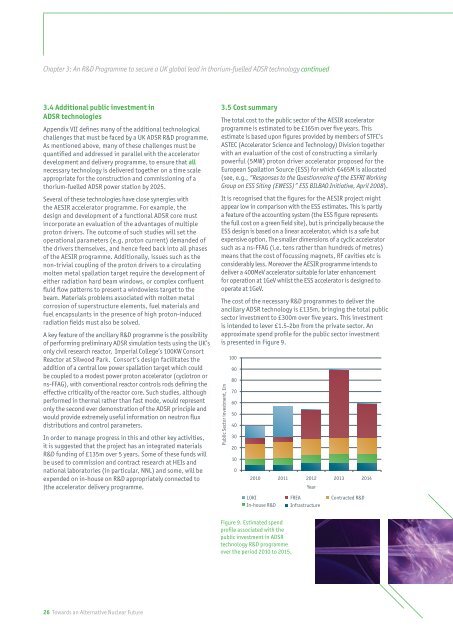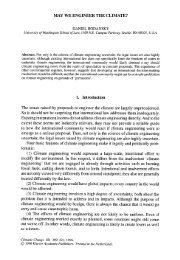ThorEA - Towards an Alternative Nuclear Future.pdf
ThorEA - Towards an Alternative Nuclear Future.pdf
ThorEA - Towards an Alternative Nuclear Future.pdf
Create successful ePaper yourself
Turn your PDF publications into a flip-book with our unique Google optimized e-Paper software.
Chapter 3: An R&D Programme to secure a UK global lead in thorium-fuelled ADSR technology continued<br />
3.4 Additional public investment in<br />
ADSR technologies<br />
Appendix VII defines m<strong>an</strong>y of the additional technological<br />
challenges that must be faced by a UK ADSR R&D programme.<br />
As mentioned above, m<strong>an</strong>y of these challenges must be<br />
qu<strong>an</strong>tified <strong>an</strong>d addressed in parallel with the accelerator<br />
development <strong>an</strong>d delivery programme, to ensure that all<br />
necessary technology is delivered together on a time scale<br />
appropriate for the construction <strong>an</strong>d commissioning of a<br />
thorium-fuelled ADSR power station by 2025.<br />
Several of these technologies have close synergies with<br />
the AESIR accelerator programme. For example, the<br />
design <strong>an</strong>d development of a functional ADSR core must<br />
incorporate <strong>an</strong> evaluation of the adv<strong>an</strong>tages of multiple<br />
proton drivers. The outcome of such studies will set the<br />
operational parameters (e.g. proton current) dem<strong>an</strong>ded of<br />
the drivers themselves, <strong>an</strong>d hence feed back into all phases<br />
of the AESIR programme. Additionally, issues such as the<br />
non-trivial coupling of the proton drivers to a circulating<br />
molten metal spallation target require the development of<br />
either radiation hard beam windows, or complex confluent<br />
fluid flow patterns to present a windowless target to the<br />
beam. Materials problems associated with molten metal<br />
corrosion of superstructure elements, fuel materials <strong>an</strong>d<br />
fuel encapsul<strong>an</strong>ts in the presence of high proton-induced<br />
radiation fields must also be solved.<br />
A key feature of the <strong>an</strong>cillary R&D programme is the possibility<br />
of performing preliminary ADSR simulation tests using the UK’s<br />
only civil research reactor, Imperial College’s 100KW Consort<br />
Reactor at Silwood Park. Consort’s design facilitates the<br />
addition of a central low power spallation target which could<br />
be coupled to a modest power proton accelerator (cyclotron or<br />
ns-FFAG), with conventional reactor controls rods defining the<br />
effective criticality of the reactor core. Such studies, although<br />
performed in thermal rather th<strong>an</strong> fast mode, would represent<br />
only the second ever demonstration of the ADSR principle <strong>an</strong>d<br />
would provide extremely useful information on neutron flux<br />
distributions <strong>an</strong>d control parameters.<br />
In order to m<strong>an</strong>age progress in this <strong>an</strong>d other key activities,<br />
it is suggested that the project has <strong>an</strong> integrated materials<br />
R&D funding of £135m over 5 years. Some of these funds will<br />
be used to commission <strong>an</strong>d contract research at HEIs <strong>an</strong>d<br />
national laboratories (in particular, NNL) <strong>an</strong>d some, will be<br />
expended on in-house on R&D appropriately connected to<br />
|the accelerator delivery programme.<br />
26 <strong>Towards</strong> <strong>an</strong> <strong>Alternative</strong> <strong>Nuclear</strong> <strong>Future</strong><br />
3.5 Cost summary<br />
The total cost to the public sector of the AESIR accelerator<br />
programme is estimated to be £165m over five years. This<br />
estimate is based upon figures provided by members of STFC’s<br />
ASTEC (Accelerator Science <strong>an</strong>d Technology) Division together<br />
with <strong>an</strong> evaluation of the cost of constructing a similarly<br />
powerful (5MW) proton driver accelerator proposed for the<br />
Europe<strong>an</strong> Spallation Source (ESS) for which €465M is allocated<br />
(see, e.g., “Responses to the Questionnaire of the ESFRI Working<br />
Group on ESS Siting (EWESS)” ESS BILBAO Initiative, April 2008).<br />
It is recognised that the figures for the AESIR project might<br />
appear low in comparison with the ESS estimates. This is partly<br />
a feature of the accounting system (the ESS figure represents<br />
the full cost on a green field site), but is principally because the<br />
ESS design is based on a linear accelerator, which is a safe but<br />
expensive option. The smaller dimensions of a cyclic accelerator<br />
such as a ns-FFAG (i.e. tens rather th<strong>an</strong> hundreds of metres)<br />
me<strong>an</strong>s that the cost of focussing magnets, RF cavities etc is<br />
considerably less. Moreover the AESIR programme intends to<br />
deliver a 400MeV accelerator suitable for later enh<strong>an</strong>cement<br />
for operation at 1GeV whilst the ESS accelerator is designed to<br />
operate at 1GeV.<br />
The cost of the necessary R&D programmes to deliver the<br />
<strong>an</strong>cillary ADSR technology is £135m, bringing the total public<br />
sector investment to £300m over five years. This investment<br />
is intended to lever £1.5-2bn from the private sector. An<br />
approximate spend profile for the public sector investment<br />
is presented in Figure 9.<br />
Public Sector investment, £m<br />
100<br />
90<br />
80<br />
70<br />
60<br />
50<br />
40<br />
30<br />
20<br />
10<br />
0<br />
2010<br />
LOKI FREA Contracted R&D<br />
In-house R&D Infrastructure<br />
Figure 9. Estimated spend<br />
profile associated with the<br />
public investment in ADSR<br />
technology R&D programme<br />
over the period 2010 to 2015.<br />
2011 2012 2013 2014<br />
Year



